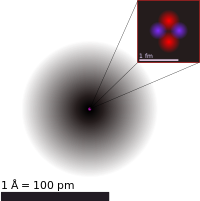
Photo from wikipedia
The paper considers alternative methods for protecting metal surfaces from corrosion-erosion destruction (CED), based on galvanization or on the use of an oxide film. Their advantages and disadvantages are noted.… Click to show full abstract
The paper considers alternative methods for protecting metal surfaces from corrosion-erosion destruction (CED), based on galvanization or on the use of an oxide film. Their advantages and disadvantages are noted. For the manufacture of CED-resistant tungsten targets, which are used in the subcritical assembly created at the NSC KIPT, it is proposed to use the method of vacuum rolling of W and Ti. A layer of Ti serves as a protective coating. To describe the process of combining these metals, a model description is proposed, which is based on the use of the Rayleigh-Taylor dissipative instability theory (DRTI). An estimate of the values of the parameters of a binary metal system subjected to DRTI is given. The obtained characteristic bonding time of dissimilar metals corresponds to that observed in experiments.
Journal Title: Problems of Atomic Science and Technology
Year Published: 2023
Link to full text (if available)
Share on Social Media: Sign Up to like & get
recommendations!